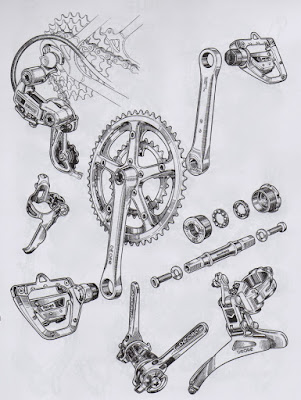Some of us try to create routes that are circular, triangular, trapezoidal or in geometric shapes with names I've forgotten. One reason, of course, is to keep from taking a back-and-forth ride: you know, the kind in which you ride to someplace and ride back to wherever you started via the same route you took to get there.
I'm guessing, though, that the majority of rides people take are of the back-and-forth variety (or what the French would call aller-retour, the same term they use for "round trip"). Those are, of course, interesting and fun in their own ways.
On such rides, the wind becomes more of a factor than on other kinds. After all, if you're riding in a circle, there are parts of your ride in which the wind won't be a factor at all, and you will probably spend less of it pedaling directly into it, or with it at your back, as you might on a more linear route.
When riding back-and-forth, most of us probably would prefer to ride into the wind on the way out and to let it blow us back home, or to wherever we started riding. At least, I know that's my preference. And I certainly got it today!
I got on Tosca, my Mercian fixed gear some time after three this afternoon. For the first five kilometers or so, to Woodside, I was riding diagonally into the wind. But lwhen I turned south on 69th Street, I was found myself riding into the teeth of a wind that varied from thirty to forty-five kilometers (about 19 to 28 miles) per hour for the twenty or so kilometers I pedaled to Rockaway Beach.
Once I got there, I wasn't surprised to see kite flyers or a kite-surfer:
The latter "wiped out". He certainly didn't have an easy time retrieving his board while holding onto his kite!
The temperature had reached 90 F (32C) before I started riding. The air felt about twenty degrees F (or ten C) cooler on the beach, under a bright, intense sun. In the middle of summer, people would go into the water, even though it would seem relatively cool. However, only the surfer braved the waves: The ocean temperature is still only around 55F (12C), cooler than most people prefer for swimming.
I could have stayed all day and all night! But I had a couple of things to do tonight, so I didn't stay long. Perhaps I could have stayed longer than I did: It took me only half as much time to make it home as it did for me to pedal to Rockaway Beach!
And, of course, you notice the wind you're pedaling into--or the one blowing you home--even more when you're riding a fixed gear!
I'm guessing, though, that the majority of rides people take are of the back-and-forth variety (or what the French would call aller-retour, the same term they use for "round trip"). Those are, of course, interesting and fun in their own ways.
On such rides, the wind becomes more of a factor than on other kinds. After all, if you're riding in a circle, there are parts of your ride in which the wind won't be a factor at all, and you will probably spend less of it pedaling directly into it, or with it at your back, as you might on a more linear route.
When riding back-and-forth, most of us probably would prefer to ride into the wind on the way out and to let it blow us back home, or to wherever we started riding. At least, I know that's my preference. And I certainly got it today!
I got on Tosca, my Mercian fixed gear some time after three this afternoon. For the first five kilometers or so, to Woodside, I was riding diagonally into the wind. But lwhen I turned south on 69th Street, I was found myself riding into the teeth of a wind that varied from thirty to forty-five kilometers (about 19 to 28 miles) per hour for the twenty or so kilometers I pedaled to Rockaway Beach.
Once I got there, I wasn't surprised to see kite flyers or a kite-surfer:
The latter "wiped out". He certainly didn't have an easy time retrieving his board while holding onto his kite!
The temperature had reached 90 F (32C) before I started riding. The air felt about twenty degrees F (or ten C) cooler on the beach, under a bright, intense sun. In the middle of summer, people would go into the water, even though it would seem relatively cool. However, only the surfer braved the waves: The ocean temperature is still only around 55F (12C), cooler than most people prefer for swimming.
I could have stayed all day and all night! But I had a couple of things to do tonight, so I didn't stay long. Perhaps I could have stayed longer than I did: It took me only half as much time to make it home as it did for me to pedal to Rockaway Beach!
And, of course, you notice the wind you're pedaling into--or the one blowing you home--even more when you're riding a fixed gear!






























